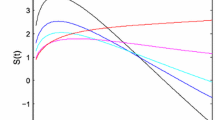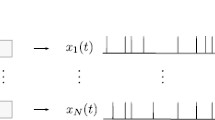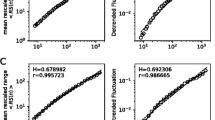Abstract
The input of Stein’s model of a single neuron is usually described by using a Poisson process, which is assumed to represent the behaviour of spikes pooled from a large number of presynaptic spike trains. However, such a description of the input is not always appropriate as the variability cannot be separated from the intensity. Therefore, we create and study Stein’s model with a more general input, a sum of equilibrium renewal processes. The mean and variance of the membrane potential are derived for this model. Using these formulas and numerical simulations, the model is analyzed to study the influence of the input variability on the properties of the membrane potential and the output spike trains. The generalized Stein’s model is compared with the original Stein’s model with Poissonian input using the relative difference of variances of membrane potential at steady state and the integral square error of output interspike intervals. Both of the criteria show large differences between the models for input with high variability.






Similar content being viewed by others
References
Avila-Akerberg O, Chacron MJ (2011) Nonrenewal spike train statistics: causes and functional consequences on neural coding. Exp Brain Res 210:353–371
Benedetto E, Sacerdote L (2013) On dependency properties of the ISIs generated by a two-compartmental neuronal model. Biol Cybern 107:95–106
Burkitt AN (2001) Balanced neurons: analysis of leaky integrate-and-fire neurons with reversal potentials. Biol Cybern 85:247–255
Burkitt AN (2006a) A review of the integrate-and-fire neuron model: I. Homogeneous synaptic input. Biol Cybern 95:1–19
Burkitt AN (2006b) A review of the integrate-and-fire neuron model: II. Inhomogeneous synaptic input and network properties. Biol Cybern 95:97–112
Câteau H, Reyes AD (2006) Relation between single neuron and population spiking statistics and effects on network activity. Phys Rev Lett 96:058101
Cox DR (1962) Renewal theory. Methuen & Co., London
Cox DR, Lewis PAW (1966) The statistical analysis of series of events. Chapman & Hall, London
Cupera J (2014) Diffusion approximation of neuronal models revisited. Math Biosci Eng 11:11–25
de la Rocha J, Moreno R, Parga N (2004) Correlations modulate the non-monotonic response of a neuron with short-term plasticity. Neurocomputing 58–60:313–319
Deger M, Helias M, Boucsein C, Rotter S (2012) Statistical properties of superimposed stationary spike trains. J Comput Neurosci 32:443–463
Di Crescenzo A, Martinucci B (2007) Analysis of a stochastic neuronal model with excitatory inputs and state-dependent effects. Math Biosci 209:547–563
Ditlevsen S, Lansky P (2011) Firing variability is higher than deduced from the empirical coefficient of variation. Neural Comput 23:1944–1966
Droste F, Lindner B (2014) Integrate-and-fire neurons driven by asymmetric dichotomous noise. Biol Cybern 108:825–843
Dummer B, Wieland S, Lindner B (2014) Self-consistent determination of the spike-train power spectrum in a neural network with sparse connectivity. Front Comp Neurosci 8:104
Gerstner W, Kistler WM (2002) Spiking neuron models. Cambridge University Press, Cambridge
Giorno W, Spina S (2014) On the return process with refractoriness for a non-homogeneous Ornstein–Uhlenbeck neuronal model. Math Biosci Eng 11:285–302
Gomez L, Budelli R, Saa R, Stiber M, Segundo JP (2005) Pooled spike trains of correlated presynaptic inputs as realizations of cluster point processes. Biol Cybern 92:110–127
Hohn N, Burkitt AN (2001) Shot noise in the leaky integrate-and-fire neuron. Phys Rev E 63:031902
Jahn P, Berg RW, Hounsgaard J, Ditlevsen S (2011) Motoneuron membrane potentials follow a time inhomogeneous jump diffusion process. J Comput Neurosci 31:563–579
Kistler WM, Gerstner W, van Hemmen JL (1997) Reduction of the Hodgkin–Huxley equations to a single-variable threshold model. Neural Comput 9:1015–1045
Kostal L, Lansky P, Rospars JP (2007a) Neuronal coding and spiking randomness. Eur J Neurosci 26:2693–2701
Kostal L, Lansky P, Zucca C (2007b) Randomness and variability of the neuronal activity described by the Ornstein–Uhlenbeck model. Netw Comput Neural 18:63–75
Koyama S, Kostal L (2014) The effect of interspike interval statistics on the information gain under the rate coding hypothesis. Math Biosci Eng 11:63–80
Lansky P (1984) On approximations of Stein’s neuronal model. J Theor Biol 107:631–647
Levakova M, Ditlevsen S, Lansky P (2014) Estimating latency from inhibitory input. Biol Cybern 108:475–493
Lindner B (2006) Superposition of many independent spike trains is generally not a Poisson process. Phys Rev E 73:022901
Lindner B, Chacron MJ, Longtin A (2005) Integrate-and-fire neurons with threshold noise: a tractable model of how interspike interval correlations affect neuronal signal transmission. Phys Rev E 72:021911
Ly C, Tranchina D (2009) Spike train statistics and dynamics with synaptic input from any renewal process: a population density approach. Neural Comput 21:360–396
Moreno R, de la Rocha J, Renart A, Parga N (2002) Response of spiking neurons to correlated inputs. Phys Rev Lett 89:288101
Musila M, Lansky P (1991) Generalized Stein’s model for anatomically complex neurons. Biosystems 25:179–191
Nawrot MP, Boucsein C, Molina VR, Riehle A, Aertsen A, Rotter S (2008) Measurement of variability dynamics in cortical spike trains. J Neurosci Meth 169:374–390
Omi T, Shinomoto S (2011) Optimizing time histograms for non-poissonian spike trains. Neural Comput 23:3125–3144
Ostojic S (2011) Interspike interval distributions of spiking neurons driven by fluctuating inputs. J Neurophysiol 106:361–373
Ricciardi LM, Sacerdote L (1979) The Ornstein–Uhlenbeck process as a model for neuronal activity, I. Mean and variance of the firing time. Biol Cybern 35:1–9
Richardson MJE, Gerstner W (2005) Synaptic shot noise and conductance fluctuations affect the membrane voltage with equal significance. Neural Comput 17:923–947
Richardson MJE, Gerstner W (2006) Statistics of subthreshold neuronal voltage fluctuations due to conductance-based synaptic shot noise. Chaos 16:026106
Richardson MJE, Swarbrick R (2010) Firing-rate response of a neuron receiving excitatory and inhibitory synaptic shot noise. Phys Rev Lett 105:178102
Salinas E, Sejnowski TJ (2000) Impact of correlated synaptic input on output firing rate and variability in simple neuronal models. J Neurosci 20:6193–6209
Shimokawa T, Koyama S, Shinomoto S (2010) A characterization of the time-rescaled gamma process as a model for spike trains. J Comput Neurosci 29:183–193
Shinomoto S, Koyama S (2007) A solution to the controversy between rate and temporal coding. Stat Med 26:4032–4038
Smith CE, Smith MV (1984) Moments of voltage trajectories for Stein’s model with synaptic reversal potentials. J Theor Neurobiol 3:67–77
Smith PL (2010) From Poisson shot noise to the integrated Ornstein–Uhlenbeck process: neurally principled models of information accumulation in decision-making and response time. J Math Psychol 54:266–283
Stein RB (1965) A theoretical analysis of neuronal variability. Biophys J 5:173–194
Tuckwell HC (1979) Synaptic transmission in a model for stochastic neural activity. J Theor Biol 77:65–81
Tuckwell HC (1988) Introduction to theoretical neurobiology: volume 2, nonlinear and stochastic theories. University Press, Cambridge
Acknowledgments
This work was supported by the Czech Science Foundation 15-06991S and by the Institute of Physiology RVO: 67985823.
Author information
Authors and Affiliations
Corresponding author
Appendix
Appendix
Here we derive formulas for mean and variance of \(S(t)\) and \(S\). It is clearly sufficient to derive mean and variance of quantity
where \(N(t)\) and \(X_i,\,i=1,\ldots ,N(t),\) correspond to an equilibrium renewal process with intensity \(\lambda \) and \(A_i,\,i=1,\ldots ,N(t),\) are positive independent and identically distributed random variables with mean \(\mu \) and variance \(\sigma ^2\). The formulas (16), (17), (18) and (19) will be simple consequences.
Firstly, let us denote,
and have \(\Delta t > 0\) and points \(t_i = i\Delta t,\,i=0,\ldots ,\lfloor t/\Delta t\rfloor \). The number of events in interval \([t_{i-1},t_i)\) is denoted as \(N_i,\) \(i=1,\ldots ,\lfloor t/\Delta t\rfloor \). Then
and thus
which simply yields
Before deriving the formulas for variance, a necessary relationship is presented. It holds (Cox and Lewis 1966)
where \(\Delta N_t\) denotes the number of events in interval \([t,t+\Delta t]\) and \(\delta (x)\) is the Dirac delta function. Note that in neuronal modeling the function (30) is known as correlation function of the spike train (Gerstner and Kistler 2002). Then
Next,
Finally, we derive the limit of the previous relationship for \(t \rightarrow \infty \). Using formula (5) we obtain
Rights and permissions
About this article
Cite this article
Rajdl, K., Lansky, P. Stein’s neuronal model with pooled renewal input. Biol Cybern 109, 389–399 (2015). https://doi.org/10.1007/s00422-015-0650-x
Received:
Accepted:
Published:
Issue Date:
DOI: https://doi.org/10.1007/s00422-015-0650-x




